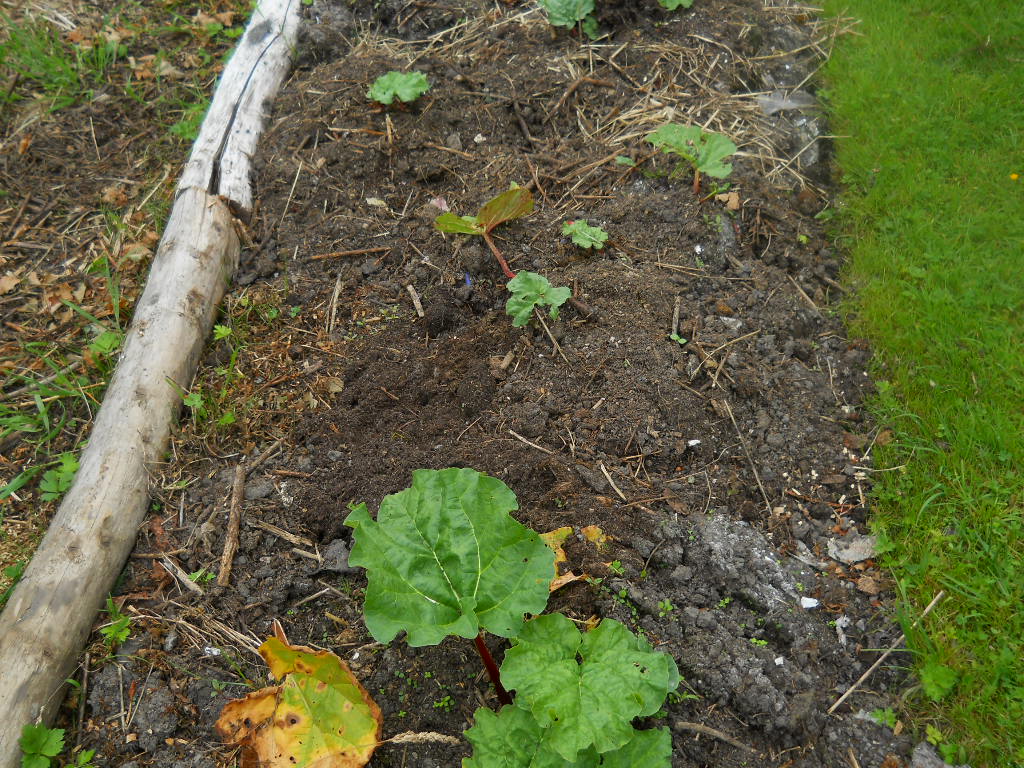

Rhubarb is an easy and early fruiting plant to grow. Although the leaves are toxic, various parts of the plants have medicinal and culinary uses. In culinary use, fresh raw stalks are crisp (similar to celery) with a strong tart taste; most commonly the plant’s stalks are cooked and used in pies and other foods for their tart flavour. Personally, there is nothing equal to a Rhubarb Crumble, or, one of my absolute favourites…Rhubarb Jam!
Did you know that in England, the first rhubarb of the year is harvested by candlelight in dark sheds dotted around the noted “Rhubarb Triangle” of Wakefield, Leeds, and Morley,a practice that produces a sweeter, more tender stalk?
The new beds are coming along well…planted out with Chard, Cucumber, Parsley, Tomato and Chives…for starters! I have spread wood ash recently on the beds and continue to build up with compost.
Chard can be harvested while the leaves are young and tender, or after maturity, when they are larger and have slightly tougher stems. Raw chard is perishes quite fast, so it’s best to pick only when about to be used!
Chard has shiny green ribbed leaves, with stems that range from white to yellow to red, depending on the cultivar. It has a slightly bitter taste. Fresh young chard can be used raw in salads. Mature chard leaves and stalks are typically cooked or sautéed; their bitterness fades with cooking, leaving a refined flavor which is more delicate than that of cooked Spinach. I use Chard a lot in my home made soups and curries and as a replacement for Spinach.
Both grow like weeds here at Bealtaine Cottage, with lots of Oregano now coming up in the gravel driveway. Great for drying and using in sauces and soups and breads!
Trees are planted all the year around here at the smallholding. Many are grown from seed and potted on several times before eventual planting out. Many are rescued from the roadside verges and gravel paths. Lots of these trees are given away to those who show an interest in planting. There is one thing for sure though, the Earth needs more trees. Trees protect her.
Now working through the second heap and already filled up the first again, so am busy as you can see!
Composting as a recognized practice dates to at least the early Roman Empire since Pliny the Elder (AD 23-79).
Traditionally, composting was to pile organic materials until the next planting season, at which time the materials would have decayed enough to be ready for use in the soil. This is the method I follow and it works every time as you can see! The advantage of this method is that little working time or effort is required from the composter and it fits in naturally with agricultural practices in temperate climates. Personally I see no disadvantages in this technique. There is no real exposure to excessive rainfall, as the heaps are thatched with lots of straw to overwinter in peace and harmony with all the hibernating insects and frogs!
Bealtaine Cottage is also on YouTube…with over 85 videos about Permaculture, planting, growing and living.
Visitors to Bealtaine Cottage are welcomed free.
Donations are always welcome.
Thank you!
Thank you for supporting this blog

